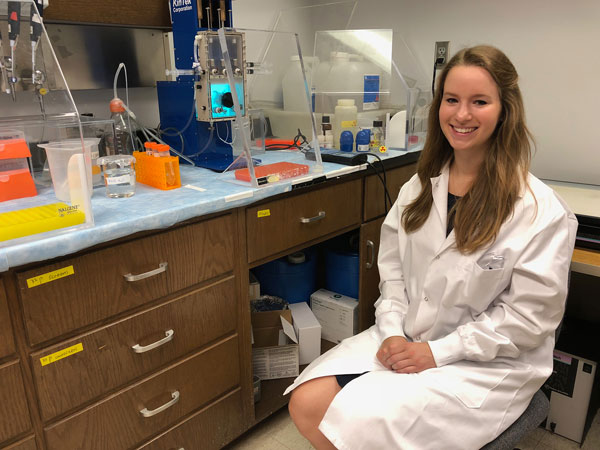Did you know that protein is related to cancer? Many of us know that protein aids in muscle growth, but fewer of us know that overproduction of protein by our bodies’ cells can enable cancerous growth, once started, to continue. This, along with other reasons, makes it incredibly important for researchers here at UAB to learn more about protein production in our cells. And that’s just what Catie Scull, a UAB doctoral student in biochemistry, is doing.

Scull’s research centers around the question, “How does altering the speed of ribosomal RNA synthesis alter ribosome assembly in our cells?” The ribosome is a tiny, but powerful, piece of cellular machinery that assembles amino acids into peptides, which may then be folded into proteins. Not the dietary proteins that come to mind when we hear the word, but substances like hemoglobin and ferritin that our bodies need to distribute oxygen and iron to the places where they are needed throughout our bodies. Scull’s research question has huge implications for these proteins and, thus, our bodies, as altering ribosome assembly naturally affects the levels of protein available to our cells to perform these essential functions. Having too much or too little protein available to our cells can cause or enable certain diseases to thrive whereas having the right level keeps our bodies functioning at optimal levels.
So, what exactly are these proteins being assembled by our ribosomes? We’ve already mentioned hemoglobin, a protein that transports oxygen via the blood, and ferritin, an iron carrier. Many of us have also heard of actin and myosin, proteins that assist in building muscle. However, these are not the only proteins that can be assembled from peptide chains. A somewhat different example of a protein that can be built by the ribosome is our antibodies, proteins used by our immune systems to neutralize pathogenic threats. There are many examples of proteins used by our bodies to function, but they are all assembled by the ribosome, which takes amino acids from our foods, “dietary proteins,” and converts them into cellular proteins.
Now, back to the ribosome that is responsible for producing these essential proteins. Ribosomes are actually made up of RNA, or “ribonucleic acid,” which performs several functions, but is principally responsible for relaying messages related to controlling the synthesis of protein. A protein nicknamed “Pol I” synthesizes this RNA to then be “folded” into a functionally active ribosome, which can then “fold” amino acids into protein. Scull’s research focuses on the first part of that equation, exploring how the rate at which Pol I synthesizes RNA affects the folding of RNA into a ribosome.

To explain her reuslts, Scull gives the analogy of a popcorn chain. One person is putting popcorn and cranberries on a thread, and another person is then wrapping a Christmas tree with the popcorn chain. If the person who is threading the popcorn and cranberries is significantly faster than the person wrapping the tree with the finished chain, then the chain is likely to be more chaotically wrapped around the tree. Conversely, if the person threading is moving at a slower pace, the second person has more time to wrap the popcorn chain neatly around the tree. Thus, the speed at which Pol I is synthesizing the RNA, our cellular popcorn chain, affects the structure of the folded RNA when it is folded into a ribosome, our Christmas tree wrapped with the popcorn chain. And the structure of the ribosome affects how well it does its job of producing proteins.
So, why does this matter to the American tax payer? An abnormally high or low level of protein production can play a role in certain diseases, like cancer, being allowed to continue progressing in the body, diseases that the American government has taken an interest in preventing and treating through the National Institute of Health. By funding this research, American taxpayers are moving the American medical community closer to effective, low-cost treatments for these diseases. Every research project that yields a greater understanding of protein production paves the way for treatments to one day be developed and further research to take place. There are also other issues in the human body related to the opposite issue – a lack of adequate protein production – and these diseases, such as anemia, could also potentially be combated more effectively using insights from this research.
At the end of the day, Scull’s research sheds light on the microscopic building blocks of the human body and how the complex process of protein production is regulated by subtle shifts in cell messengers (RNA). This research not only improves our understanding of how the human body functions on a cellular level, but could also contribute to further research related to treating debilitating diseases.